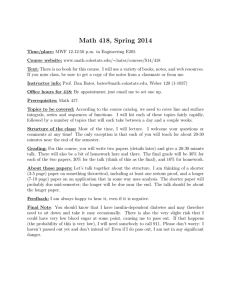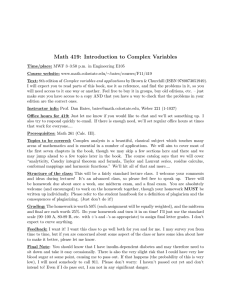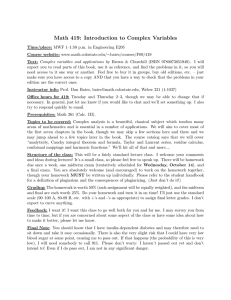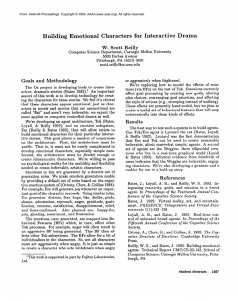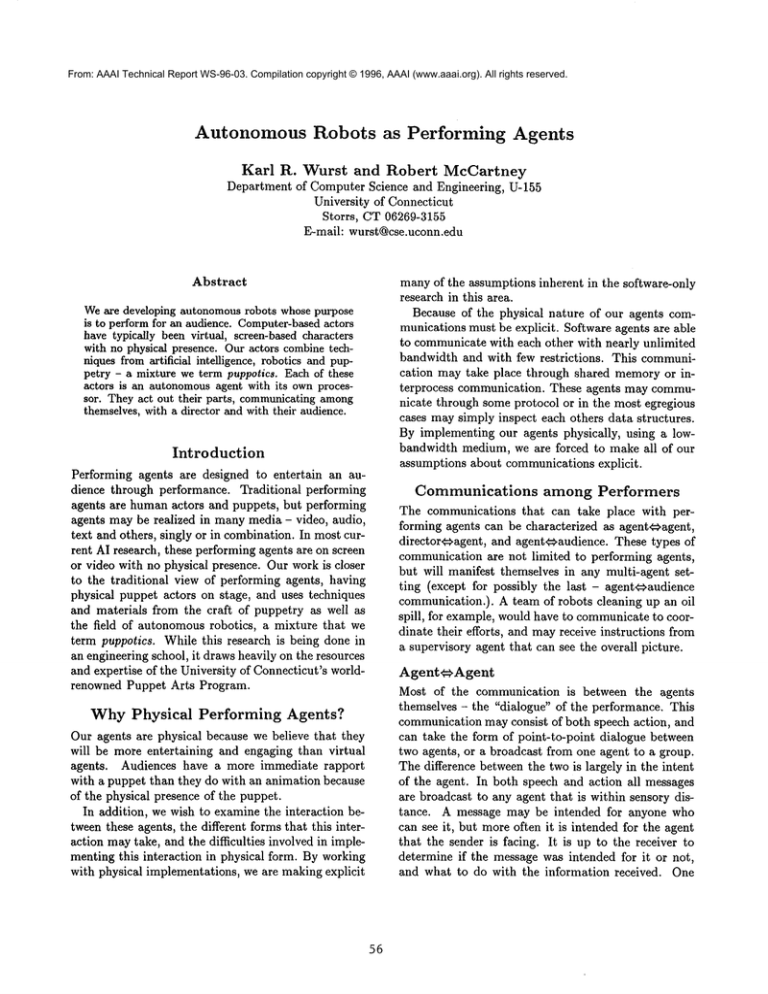
From: AAAI Technical Report WS-96-03. Compilation copyright © 1996, AAAI (www.aaai.org). All rights reserved.
Autonomous Robots
as Performing
Agents
Karl
R. Wurst
and Robert
McCartney
Department of Computer Science and Engineering, U-155
University of Connecticut
Storrs, CT 06269-3155
E-mail: wurst@cse.uconn.edu
Abstract
manyof the assumptions inherent in the software-only
research in this area.
Because of the physical nature of our agents communications must be explicit. Software agents are able
to communicate with each other with nearly unlimited
bandwidth and with few restrictions.
This communication may take place through shared memoryor interprocess communication. These agents may communicate through some protocol or in the most egregious
cases may simply inspect each others data structures.
By implementing our agents physically, using a lowbandwidth medium, we are forced to make all of our
assumptions about communications explicit.
Weare developing autonomousrobots whose purpose
is to perform for an audience. Computer-basedactors
have typically been virtual, screen-based characters
with no physical presence. Our actors combinetechniques from artificial intelligence, robotics and puppetry - a mixture we term puppotlcs. Each of these
actors is an autonomousagent with its ownprocessor. They act out their parts, communicatingamong
themselves, with a director and with their audience.
Introduction
Performing agents are designed to entertain an audience through performance. Traditional performing
agents are human actors and puppets, but performing
agents may be realized in manymedia - video, audio,
text and others, singly or in combination. In most current AI research, these performing agents are on screen
or video with no physical presence. Our work is closer
to the traditional view of performing agents, having
physical puppet actors on stage, and uses techniques
and materials from the craft of puppetry as well as
the field of autonomous robotics, a mixture that we
term puppotics. While this research is being done in
an engineering school, it draws heavily on the resources
and expertise of the University of Connecticut’s worldrenowned Puppet Arts Program.
Why Physical
Performing
Agents?
Our agents are physical because we believe that they
will be more entertaining and engaging than virtual
agents. Audiences have a more immediate rapport
with a puppet than they do with an animation because
of the physical presence of the puppet.
In addition, we wish to examine the interaction between these agents, the different forms that this interaction maytake, and the difficulties involved in implementing this interaction in physical form. By working
with physical implementations, we are making explicit
56
Communications
among Performers
The communications that can take place with performing agents can be characterized as agent~agent,
director~=~agent, and agentC~audience. These types of
communication are not limited to performing agents,
but will manifest themselves in any multi-agent setting (except for possibly the last - agentC~audience
communication.). A team of robots cleaning up an oil
spill, for example, would have to communicateto coordinate their efforts, and mayreceive instructions from
a supervisory agent that can see the overall picture.
Agent~=~Agent
Most of the communication is between the agents
themselves - the "dialogue" of the performance. This
communication may consist of both speech action, and
can take the form of point-to-point dialogue between
two agents, or a broadcast from one agent to a group.
The difference between the two is largely in the intent
of the agent. In both speech and action all messages
are broadcast to any agent that is within sensory distance. A message may be intended for anyone who
can see it, but more often it is intended for the agent
that the sender is facing. It is up to the receiver to
determine if the message was intended for it or not,
and what to do with the information received. One
could imagine an agent "eavesdropping" on a conversation between other agents and using the information
to change its own internal state in some way - becoming angry perhaps.
DireetorC~Agent
Traditionally communication is from the director to
the actors only, and takes place before the actual performance. An example of this is what Hayes-Roth calls
directed improvisation(Hayes-Roth et al. 1994). The
agents are given high-level, abstract instructions by the
director, and improvise the specifics. However,it may
be useful to have directions interjected by the director
throughout the performance, as a way of keeping the
story on track(Kelso, Weyhrauch,~; Bates 1992) These
directions from the external director would likely add
to or change the agent’s goals, to force the agent’s performance to come into line with the director’s overall
plan. Other forms of director to agent communication
can be imagined, such as a supervisor directing working robots to concentrate their efforts on a particular
area of a problem.
Although it is not commonlyseen, agent to director
communication is also possible. This would allow the
agents to inform the director of their internal state
(possibly as a response to a query from the director,)
or to request new instructions if they get stuck.
Agentc~Audience
The goal of performance is communication between the
actors and the audience, with the performer trying to
get his message across. There must be a commonlanguage that the audience and the performer both understand with conventions for certain concepts. This is
one of the areas where we are drawing on the expertise
of the puppetry field, where the issues of communication with the audience, often with non-verbal agents
with limited physical expression, is explored.
Communicationalso occurs from the audience to the
performer and the importance of this communication
varies with the type of the performance. In performances from a fixed text, audience reaction may only
be used by the actor at a subconscious level, while in
a improvisational performance, audience participation
may make or break the performance. Possible uses
for this type of communication would be to allow the
agents to take a bowto applause, respond to a heckler,
or even to adjust its timing to audience response.
The
Woggles
Our agents are based on the Woggles of the Oz Project
at CMU(Loyall& Bates 1993). The Woggles are video
actors, depicted as spheres, that exist in a video landscape. They move through this landscape and interact
57
with each other and with a human-controlled woggle.
They communicate with each other by gesturing. The
Wogglesare also in use at Stanford in the Virtual Theater project(Hayes-Roth 1995).
The Woggles choose their actions based on their internal emotional and physical states, their personalities, and interaction with each other. Each woggle has
a distinct personality that affects howit will go about
attempting to satisfying its goals. In the CMUWoggle
world, The Edge of Intention, there are three woggles
- Wolf, Shrimp and Bear. Wolf and Shrimp have aggressive and shy personalities respectively. Each may
have the goal of amusinghimself, but the differences in
their personalities will cause them to satisfy this goal
differently. Shrimp may decide to go dance around by
himself to amuse himself, while Wolf may decide to go
pick on Shrimp.
Their performances are unstructured, that is, there
is no script or plot that they follow in their performance, and are entirely interaction-driven. They communicate entirely by making physical gestures and visually observing the gestures of others. Their repertoire of gestures includes "Say Hey" - a greeting gesture, squash down, puff up, threaten and spin. This
limited numberof gestures leads to simple interactions
- woggles can gesture at each other, and movetoward
or away from other woggles. There is no external direction of their actions at this time.
Our immediate goal for our physical agents, the
ROBOWOGGLES,
is to reproduce the video version of
the Woggles as closely as possible with physical devices. Wewish to duplicate the behaviors as well as
mimic the visual aspects of the original Woggles as
muchas possible.
The fact that there is a behavioral model already
developed for the Woggles, with appropriate gestures
for communication makes them attractive as a starting point for our research. Their simplicity, both in
processing and in physical design and range of motion,
makes them suitable for physical agents.
Implementing
Woggles
Our physical implementation matches the ideal quite
well as far as gestures are concerned, and adds individual, internal control to each woggle. The body is
a ten inch diameter flexible sphere that is mechanically deformable. This allows the characteristic woggle gestures of puff up, squash down and so on. This
is accomplished with two servomotors connected to an
armature that can deform the body at the top and
sides (see Figure 2.)
The woggle is controlled by a system based on
the Motorola 68HCll microcontroller.
The system is
Communication between woggles is performed by
a line-of-sight,
low-bandwidth infrared communication
system. Transmission of gestures is broadcast 360° by
four transmitters (each covering 90°.) Each transmitter broadcasts the identity of the woggle performing
the gesture and the position of the transmitter itself
(front, back, right or left) as well as the gesture. This
allows a receiving woggle to determine the identity and
facing of the transmitting woggle, as well as turning or
spinning behavior (by observing the transmitters’ signals over time.)
Reception is from the front of the receiver only. In
other words, a woggle can only see what another woggle
is doing if it is looking at (facing) it, but a wogglecan
see what other woggles are doing, even from behind
them.
State
of Implementation
At this time, the prototype microcontroller system is
working. Another group in our laboratory has developed the CHICKENBOARD
- a general,
expandable,
modular robot controller system that will eventually
replace the prototype system nowin use.
The base mechanics with the drive and steering
mechanismare completed as well as the body deformation mechanism. Wenow beginning to build multiple
bases.
A prototype body was made from reticulated
foam
(a material commonly used for puppet bodies - including the MuppetsTM.) Unfortunately, it did not
have quite the flexing characteristics hoped for, and
the amount of sewing necessary to produce it made it
prohibitive for makingmultiple bodies.
Weare in the process of producing a new flexible
body. The new body will be cast from neoprene, and
the casting process will allow multiple bodies to be
produced easily.
Figure 1: Prototype RoboWoggle
based on Marvin Green’s BOTBoard,modified to provide an additional 32K of memory. It can control 4
servomotors, and has a number of analog and digital
inputs, and digital outputs.
The most notable departure from the video woggles
is the ROBOWOGGLES’
method of propulsion. Rather
than attempt the potentially very difficult mechanical
engineering problem of producing jumping behavior,
we opted instead for having the RoBoWOGGLES
roll
about on two wheels. The two wheels are differentially
driven, allowing the woggles to spin in place as well as
movearound on the floor.
The woggles’ communication is visual: one agent
makes a physical gesture, the other observes it. In a
"traditional" vision system a camera or similar sensor
would capture the complete scene before the agent. A
vision processing system would then determine which
elements of the scene should be grouped together to
form individual objects or agents. Finally, the system
must watch the changes in pose of an agent over time
to determine what gesture it is performing.
Wepropose a simpler, but functionally equivalent
vision system that eliminates the need for most of the
visual input processing. In our "vision-less" vision system, each agent simultaneously gestures and transmits
information about the gesture to all agents around him.
This vision system should be indistinguishable from a
"traditional" vision system from the audience’s point
of view. It still involves active sensing and processing
of visual information to determine what another agent
is doing.
Future
Work
The communicationsystem is still in the design stages.
A simple infrared scheme (as in consumer electronics
remote control systems) is sufficient to transmit the
gesture "vocabulary" needed to mimic vision, but we
need to develop communication protocols that can be
extended to support broadcast communications and reception of external direction. This extended protocol
will need to be able to communicatenew goals, change
the priorities of goals for an agent, or give explicit instructions, and may implemented using different communication hardware.
Weneed to develop a communications protocol that
can transmit the entire gesture vocabulary needed by
the ROBOWOGGLES. Thay protocol must operate over
58
Figure 2: Deformation and locomotion mechanics (squash, normal, and "Say hey")
limited-bandwidth IR channels, and provide the information necessary to mimic vision. The protocol will
have to be extendable to include commands from a
director, or another communication system could be
used for external direction. The nature of these external direction commandsneeds to be explored further
to determine what exactly should be transmitted, and
what effect it should have on the internal state of the
agents.
Weplan to look into
by providing some type
require either somesort
plementation of external
sations from getting out
performance on track
Related
Work
The Oz Project at CMU(Bates 1992) is developing
tools to support virtual worlds with believable agents
that humans can interact with. The Woggles and their
world, The Edge of Intention are just one of the systems that they are building with these tools. They
have developed an integrated agent architecture called
Tok(Bates, Loyall, & Reilly 1992) which includes a reactive component, Hap(Loyall ~ Bates 1991), an emotion system, Em(Reilly & Bates 1992), and a natural
language system, Glinda. A major thrust of their work
is external direction with the goal of being able to immerse a human in a complete dramatic work. They
want the system to be able to improvise responses to
the human’sactions, while still maintaining the overall
structure and goals of the plot.
The Virtual Theater project at Stanford(Hayes-
structuring the performances
of plot mechanism. This will
of script to follow, or the imdirection to keep the improviof control and keep the overall
59
References
Roth, Brownston, & Sincoff 1995) is also concerned
with directed improvisation, but as a more general
paradigm for human-computer interaction. Their system, the Virtual Theater, uses the Wogglesas an environment for children to write and perform plays. The
children maywrite out detailed scripts for the characters to perform, create abstract stories for the characters to improvise, or directly control the characters as
video puppets. The children can mix these modes, and
in fact, switch between them at any time.
Bates, J.; Loyall, A. B.; and Reilly, W. S. 1991. Broad
agents. In Proceedings of the AAAI Spring Symposium on Integrated Intelligent Architectures. Available in SIGART Bulletin, Volume 2, Number 4, August 1991, pp. 38-40.
Bates, J.;
tegrating
agent. In
ference of
The ALIVE System at the MIT Media Lab(Maes
et al. 1996) presents a virtual world populated
by autonomous agents with their own goals and intentions, modeled with their Hamsterdam(Blumberg
1994) agent toolkit. It has a novel interface that allows use of the user’s entire body to interact with the
agents. It does this by projecting a video image of the
user onto a large projection screen, placing the user
into the virtual world. The user sees himself interacting with the agents and objects he sees. The system
interprets the user’s actions through video processing
that identifies the user’s gestures.
Loyall, A. B.; and Reilly, W. S. 1992. Inreactivity, goals, and emotion in a broad
Proceedings of the Fourteenth Annual Conthe Cognitive Science Society.
Bates, J. 1992. The nature of characters in interactive worlds and the Oz Project. Technical Report CMU-CS-92-200, School of Computer Science,
Carnegie Mellon University, Pittsburgh, PA.
Blumberg, B. 1994. Action-selection in Hamsterdam:
lessons from ethology. In Proceedings of the Third International Conference on the Simulation of Adaptive
Behavior.
Hayes-Roth, B.; Sincoff, E.; Brownston, L.; Huard,
R.; and Lent, B. 1994. Directed improvisation. Technical Report KSL-94-61, Knowledge Systems Laboratory, Stanford University, Palo Alto, CA.
Hayes-Roth, B.; Brownston, L.; and Sincoff, E. 1995.
Directed improvisation by computer characters. Technical Report KSL-95-04, Knowledge Systems Laboratory, Stanford University, Palo Alto, CA.
Conclusions
Weare building physical implementations of performing agents whose main purpose is to provide entertainment for an audience.
The ROBOWOGGLES are an
example of puppotics - a combination of artificial
intelligence, robotics and puppetry technologies. They
communicatewith each other by physical gestures, and
communicatethose gestures over an infrared communication system, while performing the actual gesture for
the audience. These simple performing agents provide
a good starting point for exploring performances with
more complex plots and interactions and the possibility of external direction of the agents. In addition, we
are exploring the issues involved in the communication
among the agents and between the agents and an external director. The communication issues that must
be addressed are not limited to performing agents, but
will manifest themselves in any setting where multiple
agents are working together.
Hayes-Roth, B. 1995. Agents on stage: Advancing the
state of the art of AI. In Proceedingsof the Fourteenth
International Joint Conference on Artificial Intelligence.
Kelso, M. T.; Weyhrauch, P.; and Bates, J. 1992.
Dramatic presence. Technical Report CMU-CS-92195, School of Computer Science, Carnegie Mellon
University, Pittsburgh, PA.
Loyall, A. B., and Bates, J. 1991. Hap: A reactive, adaptive architecture for agents. Technical Report CMU-CS-91-147, School of Computer Science,
Carnegie Mellon University, Pittsburgh, PA.
Loyall, A. B., and Bates, J. 1993. Real-time control of animated broad agents. In Proceedings of the
Fifteenth Annual Conference of the Cognitive Science
Society.
Maes, P.;
A. 1996.
teraction
Systems.
Acknowledgements
Thanks to Christian Netter for all his help in developing the prototype controller board and the CHICKENBOARD.Thanks to Bartolo P. Roccoberton Jr.,
head of the University of Connecticut Puppet Arts
Program for providing the expertise needed to make
the ROBOWOGGLES real.
Darrell, T.; Blumberg, B.; and Pentland,
The ALIVESystem: wireless, full-body inwith autonomous agents. A CMMultimedia
To be published.
Reilly, W. S., and Bates, J. 1992. Building emotional
agents. Technical Report CMU-CS-92-143,School of
ComputerScience, Carnegie Mellon University, Pittsburgh, PA.
60


